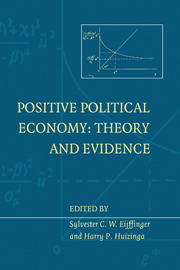Book contents
- Frontmatter
- Contents
- List of figures
- List of tables
- List of contributors
- Foreword
- Introduction
- I Monetary institutions and policy
- 1 Reputational versus institutional solutions to the time-consistency problem in monetary policy
- Comment
- 2 Reciprocity and political business cycles in federal monetary unions
- 3 The ultimate determinants of central bank independence
- 4 Central bank autonomy and exchange rate regimes – their effects on monetary accommodation and activism
- 5 Uncertainty, instrument choice, and the uniqueness of Nash equilibrium: microeconomic and macroeconomic examples
- 6 New empirical evidence on the costs of European Monetary Union
- II Exchange rate policy and redistribution
- Index
Comment
from 1 - Reputational versus institutional solutions to the time-consistency problem in monetary policy
Published online by Cambridge University Press: 05 September 2013
- Frontmatter
- Contents
- List of figures
- List of tables
- List of contributors
- Foreword
- Introduction
- I Monetary institutions and policy
- 1 Reputational versus institutional solutions to the time-consistency problem in monetary policy
- Comment
- 2 Reciprocity and political business cycles in federal monetary unions
- 3 The ultimate determinants of central bank independence
- 4 Central bank autonomy and exchange rate regimes – their effects on monetary accommodation and activism
- 5 Uncertainty, instrument choice, and the uniqueness of Nash equilibrium: microeconomic and macroeconomic examples
- 6 New empirical evidence on the costs of European Monetary Union
- II Exchange rate policy and redistribution
- Index
Summary
Over recent years a consensus view has emerged in the macroeconomic literature on how governments may be able to overcome the deadlock of time-consistent inflation. The solution is handing the authority over monetary policy to an independent institution. In her chapter, Susanne Lohmann challenges this view. She even claims the conventional wisdom that institutions matter to be flawed.
In my comment, I will first provide a short overview of what we know about different institutional solutions to the time-consistency problem in monetary policy, next discuss why institutional solutions dominate reputational solutions, and, finally, take issue with a few related arguments.
Table 1.1 presents an overview of the different institutional approaches the government may choose for reducing the loss from time-consistent inflation. I believe it is useful to equate institutional solutions with precommitment rather than commitment. Commitment is just the promise of a specified policy path or conduct. Delivering on the promise yields credibility, the extent of which depends on how long good conduct is maintained. Thus, it takes time for the promise to be perceived as credible. Precommitment, in contrast, provides credibility on the spot, because it rests on legal constraints of government behavior.
Another point to note is that we need to spell out the nature of the constraints that make up an institutional solution. For example, delegating policy to a conservative central banker does not provide the lower expected or permanent rate of inflation computed by Rogoff (1985) if this banker can be dismissed at any time during his term.
- Type
- Chapter
- Information
- Positive Political EconomyTheory and Evidence, pp. 22 - 28Publisher: Cambridge University PressPrint publication year: 1998



